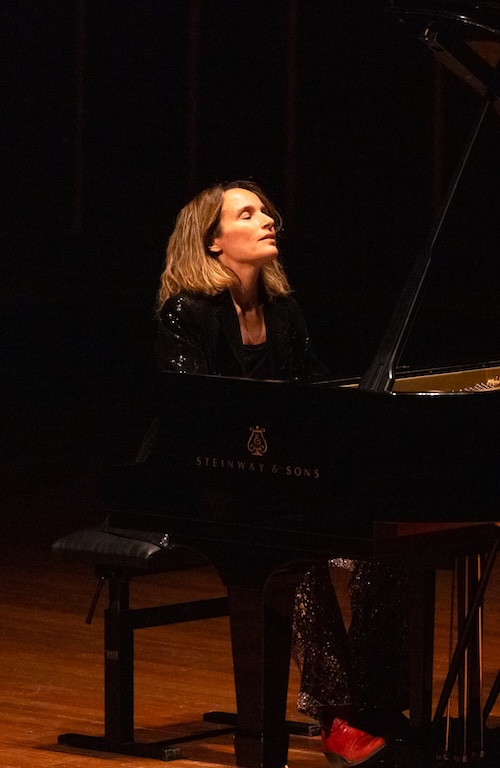Grimaud’s emphatic pianism pays mixed rewards for the Celebrity Series

Some pianists are born to play Brahms, some Beethoven, some Bach, and some Busoni. Then there’s Hélène Grimaud, whose belated, Celebrity Series-sponsored Boston recital debut at Jordan Hall on Saturday night tackled the music of all four.
Given the French pianist’s unapologetically assertive way with the keyboard, the evening’s interpretive results varied, though her technical command of this repertoire was never in question. Sometimes, as was the situation in Ferruccio Busoni’s Herculean arrangement of the Chaconne from Johann Sebastian Bach’s D-minor Solo Violin Sonata, she reveled in bold plays of color, texture, and dynamics.
At the same time, Grimaud’s pianism can occasionally take on a blunt quality, her dynamic range hampered and tone edgy. A bit of that materialized at Jordan Hall, too, especially in Beethoven’s Piano Sonata No. 30, Op.109.
But when it finds its happy place, her musicianship comes compellingly to life. On Saturday, this occurred most affectingly in the night’s two encores as well as in selections by Johannes Brahms.
The latter’s Three Intermezzi, Op. 117, with their blend of bittersweet lyricism and surging turbulence, emerged invitingly, Grimaud imbuing the triptych with a mix of tonal warmth and noble resonance. She dispatched the first two movements with limpid fluency while the mysterious finale unspooled with impeccable balances and a touching, melancholic aspect.
In Brahms’ Seven Fantasies, Op. 116, Grimaud underlined the music’s strong play of contrasting characters. Though the opening Capriccio took a few bars to settle, both outer movements breathed fire.
Between them came a series of striking moments, big and small. Catharsis was had in the first Intermezzo’s brief turns to the major while a picture of serenity transpired in Grimaud’s fluent shaping of the central Adagio. Meantime, the pianist built just the right degree of tension into the third Intermezzo’s nervously pulsing figures and the penultimate movement’s play of dissonances sang with beguiling richness.
The last characteristic also carried over into Grimaud’s account of Busoni’s 1907 arrangement of the Bach, which began with appealing sumptuousness though, by the end, the work took on an exhausting insistence.
That wasn’t a result of technical deficiencies: Grimaud’s reading was astonishingly focused and, throughout, cleanly voiced. The score’s motoric figurations spoke with biting evenness and precision. Whole passages were carried along with thrilling, sweeping momentum.
But periodic mono-dynamic textures and consistently brisk tempos took a toll. Ultimately, Busoni’s showy, cascading, quasi-orchestral conception of the movement seemed at fault, inadvertently reminding one of the old adage that “less is more.”
Beethoven’s ante-penultimate Sonata in E major recalls the same saying but for better reasons, namely, a brilliant economy of materials and sheer musical invention.
Grimaud’s performance underlined some of those qualities and boasted conspicuous strengths, including shapely lines in the outer movements and, during the Prestissimo, demonstrations of lean, driving vigor. Its radical voicings in extreme ranges also came out potently, as did much of Beethoven’s zesty contrapuntal writing in the finale.
But on Saturday one missed the searing, poetic insights and expressive extremes Igor Levit mined from the same work in this very hall last year. Instead of the Russian-German pianist’s spiritual focus, Grimaud’s dry, somewhat clinical tone, literal approach to balances, and all-over-the-map phrasings resulted in a rendition of the score that, despite its assets, felt strangely detached and emotionally sterile.